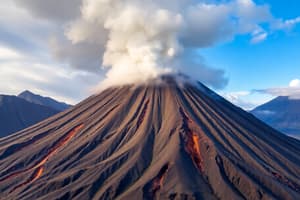Podcast
Questions and Answers
Which type of volcano is characterized by a broad, slightly domed structure resembling a warrior's shield?
Which type of volcano is characterized by a broad, slightly domed structure resembling a warrior's shield?
- Composite Volcano
- Phreatomagmatic Volcano
- Cinder Cone Volcano
- Shield Volcano (correct)
What is the name given to the molten rock that is ejected from a volcano onto the Earth's surface?
What is the name given to the molten rock that is ejected from a volcano onto the Earth's surface?
- Ash
- Tephra
- Lava (correct)
- Magma
Which type of volcanic eruption is characterized by the interaction of water and magma, leading to a violent eruption of fine ash?
Which type of volcanic eruption is characterized by the interaction of water and magma, leading to a violent eruption of fine ash?
- Phreatic
- Phreatomagmatic (correct)
- Strombolian
- Vulcanian
What is the term used to describe a large volcanic crater formed when a portion of the volcano's wall collapses following an explosive eruption?
What is the term used to describe a large volcanic crater formed when a portion of the volcano's wall collapses following an explosive eruption?
What type of volcano is Mount Paricutin in Mexico, known for its steep slopes, wide crater, and being the most common type?
What type of volcano is Mount Paricutin in Mexico, known for its steep slopes, wide crater, and being the most common type?
Which of the following is NOT a type of volcanic eruption?
Which of the following is NOT a type of volcanic eruption?
Which type of volcanic eruption is characterized by tall eruptions reaching up to 20 kilometers high with pyroclastic flows and ash tephra?
Which type of volcanic eruption is characterized by tall eruptions reaching up to 20 kilometers high with pyroclastic flows and ash tephra?
What is the name of the hot, fluid, or semi-fluid material beneath or within the Earth's crust, typically composed of molten rock?
What is the name of the hot, fluid, or semi-fluid material beneath or within the Earth's crust, typically composed of molten rock?
Flashcards
Volcano
Volcano
Natural openings in the Earth's surface for molten rock, gases, and ash.
Crater
Crater
Funnel-shaped depression at the top of a volcano formed by explosive eruptions.
Caldera
Caldera
Large volcanic crater formed when a volcano's wall collapses after an eruption.
Magma
Magma
Signup and view all the flashcards
Lava
Lava
Signup and view all the flashcards
Shield Volcano
Shield Volcano
Signup and view all the flashcards
Cinder Cone Volcano
Cinder Cone Volcano
Signup and view all the flashcards
Phreatic Eruption
Phreatic Eruption
Signup and view all the flashcards
Study Notes
Volcanoes and Volcanic Eruptions
- Volcanoes are natural openings in the Earth's surface where molten rock, smoke, gases, and ash are ejected.
- Mayon Volcano in the Philippines is one of the world's most active volcanoes and known for its perfectly cone-shaped structure.
- Volcanoes have three main parts: the base, the slope, and the summit where the crater or opening is located.
- A crater is a funnel-shaped depression at the top of a volcano formed by explosive eruptions, serving as the volcano's mouth or opening.
- Taal Volcano in Batangas, Philippines, has 47 craters.
- A caldera is a large volcanic crater formed when a portion of the volcano's wall collapses following an explosive eruption.
- Caldera collapse is often caused by the emptying of the magma chamber beneath the volcano during a significant eruption.
- Magma is hot, fluid, or semi-fluid material beneath or within the Earth's crust, typically composed of molten rock.
- Lava is the name for magma that has been ejected from a volcano onto the Earth's surface, deriving from the Italian word "to slide," describing the molten rock's movement.
- Volcanoes can be classified based on their shape and eruption type.
Volcano Types by Shape
- Shield Volcano: Formed by the accumulation of lava flowing freely from the volcano. It has a broad, slightly domed structure resembling a warrior's shield. An example is Mauna Loa in Hawaii.
- Cinder Cone Volcano: Built from ejected lava fragments. They have steep slopes, wide craters, and are the most common type of volcano. They are also known as scoria cones. Mount Paricutin in Mexico is an example.
- Composite Volcano: Also known as stratovolcanoes, they are large, nearly perfectly sloped structures formed by alternating layers of solidified lava and pyroclastic deposits. Volcanologists consider these some of Earth's grandest mountains. Mayon Volcano is a prime example.
Volcano Types by Eruption
- Phreatic: A steam-driven eruption caused by the contact of hot rocks with water. Also known as hydrothermal eruption. An example is the Taal Volcano eruption in January 2020.
- Phreatomagmatic: A violent eruption resulting from the interaction of water and magma, leading to a violent eruption of fine ash.
- Strombolian: A series of weak to violent eruptions characterized by fountain lava.
- Vulcanian: Characterized by tall eruptions reaching up to 20 kilometers high with pyroclastic flows and ash tephra.
- Plinian: An excessively explosive eruption of gas and pyroclastics, resulting in an intensely violent eruption. Mount Pinatubo's 1991 eruption is an example.
Volcano Activity
- Active Volcano: A volcano with a recorded history of eruption.
- Inactive Volcano: A volcano that shows no activity and has no record of eruption, like Mount Kanlaon in Negros Occidental, Philippines.
Conclusion
- Although volcanoes are associated with destructive events, they play a crucial role in supporting life on Earth. Their activity contributes to the Earth's warmth and water cycle, essential elements for sustaining life.
Studying That Suits You
Use AI to generate personalized quizzes and flashcards to suit your learning preferences.



